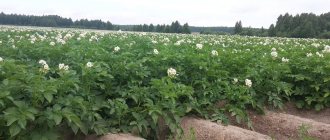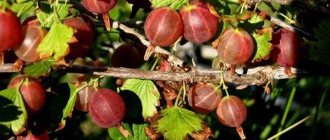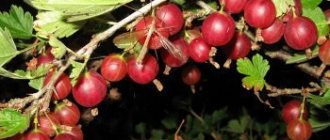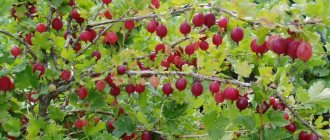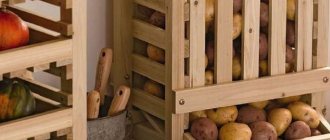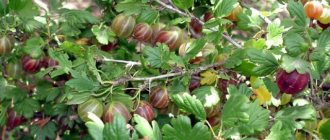Gooseberry Kolobok is a high-yielding variety with a medium ripening period. It has earned its popularity due to its small number of thorns and aromatic sweet berries.
From the article you will learn the pros and cons of this variety, features of agricultural technology and methods of combating the most common diseases and pests of gooseberries.
Gooseberry variety "Kolobok"
The gooseberry bush “Kolobok” is covered with numerous shoots, practically devoid of thorns
The characteristic pleasant taste provided the Kolobok variety with a tasting score of 4.5 points out of a possible 5
Short story
In 1977, at VSTISP, I. Popova conducted tests on the development of a new mid-early table gooseberry variety, which could be grown both in Central Russia and in the northern regions of its central zone.
The breeder took as a basis two varieties that were popular at that time: Smena and Pink 2. The resulting hybrid inherited all the best qualities of its ancestors: weak thorniness, large fruit, resistance to powdery mildew.
In 1988, Kolobok was included in the State Register. The variety immediately became in demand among both summer residents and professional gardeners. Kolobok is recommended for cultivation in Eastern Siberia, as well as other regions of Russia:
- Volgo-Vyatka;
- Central;
- Central Black Earth.
Some gardeners successfully grow the crop in more northern regions, covering it with spunbond for the winter. However, in this case, there remains a risk of gooseberries freezing due to sudden temperature changes.
Appearance of gooseberry variety Kolobok
Gooseberry Kolobok is a vigorous shrub with beautiful large leaves.
The beginning of flowering occurs at the end of April, then the bush is strewn with medium-sized light green flowers with a pink rim. The shoots are powerful, the crown is thick.
During the fruiting period, the lower branches literally lie on the ground, which contributes to the rotting of the berries and complicates the harvest. The variety is slightly thorny - single short thorns are visible at the nodes on the lower part of the stems.
Bush
The height of the plant usually does not exceed 1-1.5 m. The shrub is spreading, the branches are strongly curved towards the ground. The shoots are dark green, without pubescence.
The first 2-3 years after planting Kolobok grows quite intensively, then the growth rate slows down.
Gooseberry leaves are large, smooth, with smooth edges. The petioles are short but thick. The buds are dark brown, large.
The tillering density of Kolobok is high, so for successful fruiting the bush requires regular pruning.
Berries
The main advantage of Kolobok is its dark red sweet berries. They can be medium up to 3 g, or large - 5-8 g.
The fruits are round-oval in shape and have an intense waxy coating. When fully ripe, they do not fall off for a long time and are easily separated from the branches when harvesting. The skin is medium in density and does not burst when pressed.
The pulp is juicy, sweet, with a slight sourness. Each berry contains 18-20 medium-sized seeds.
See below for a review of one of the most famous gooseberry varieties, “Kolobok”:
The variety is considered a table variety, but the tasting commission rated the taste of Kolobok at 4.5 points out of a possible 5.
Advantages and disadvantages
Kolobok is an overall good variety that reaches its full potential in temperate climates. Its advantages:
- rapid entry into fruiting;
- delicious beautiful berries;
- high productivity;
- ease of care;
- disease resistance;
- a small number of thorns;
- self-fertility;
- easily propagated by cuttings and layering;
- The berries do not fall off for a long time, are well stored and can withstand transportation.
Disadvantages of the Kolobok variety:
- low resistance to drought, especially long-term;
- does not tolerate thaws in winter;
- the bush is very thick and requires constant pruning;
- the shoots are long, thin, and sometimes fall to the ground under the weight of the fruit without a garter;
- average ripening time - in the south, the berries can be damaged by the sun; in cold regions, sometimes not all of them have time to ripen.
Advantages and disadvantages
An important advantage of Kolobok over other mid-season varieties is its early fruiting - the crop begins to bear fruit in 2-3 years. If you follow the planting rules and proper care, gooseberries bear fruit in one place for 25-30 years.
Other advantages of the Kolobok variety include:
- frost resistance;
- extended fruiting period;
- medium and large fruit size;
- disease resistance;
- good transportability;
- presentable appearance;
- weakly prickly.
The variety is undemanding to agricultural technology, therefore it is successfully grown even by inexperienced summer residents. The disadvantages of Kolobok are:
- tendency to thicken the crown;
- spreading of the bush;
- instability to sudden changes in air temperature.
Features of agricultural technology
Gooseberries need a sunny place and moderately fertile soil, preferably with a slightly acidic reaction. The culture is undemanding to soils; it only does not accept cold, strongly acidic soils that constantly soak.
Kolobok gooseberry bushes should be planted freely, at a distance of approximately 1.5-2 m from each other and 2-2.5 m between rows. It will grow in one place for at least 15 years, the long branches are thin and curved. The variety needs a lot of space.
The best time for planting is spring in temperate and cool climates, autumn in the south.
The root collar is buried 5-8 cm. If there is only one shoot, it is placed at an angle of 30-45°. An older bush is buried deeper, and the side branches are spread to the sides and sprinkled with earth.
In dry summers, 4-5 waterings may be needed. The soil is loosened to a depth of 6 cm and freed from weeds. In the spring, fertilizers with a high nitrogen content are applied to each bush; in the fall, when digging the trunk circle, humus and ash are applied.
The branches are regularly pruned, and the adult bush is rejuvenated. In late autumn, they build a shelter for the winter. The shoots must be rationed so that the berries do not become smaller. Excess shoots can be planted or cut out at ground level.
There is nothing complicated in caring for Kolobok gooseberries. Even the most difficult operation - pruning - can be done by novice gardeners, since the shoots are almost devoid of thorns. Sweet berries, early fruiting, high yield and disease resistance make the variety desirable in any area.
Preparing for landing
Preparation of the site for planting gooseberries begins 2-3 months in advance. An important step is to remove weeds, especially wheatgrass. This can be done either manually or using herbicides.
To increase soil fertility, apply organic fertilizers at the rate of 2-3 kg per 1 square meter. m.
Areas with poor soil are additionally fertilized with superphosphate 50 g, potassium chloride 20 g and urea 25-30 g per 1 sq. m. m.
To improve aeration, river sand is added. After applying fertilizer, the area should be dug deeply and watered.
Read useful information on how to properly plant and grow gooseberries.
Plot
Sandy, sandy loam, loamy and even clay soil is suitable for gooseberries. However, it does not tolerate acidic, swampy and cold soil at all. The optimal soil pH is 6.
Avoid planting shrubs in areas with high groundwater levels, as excess moisture leads to rotting of the roots and death of the gooseberry.
Gooseberries are a light-loving crop, so you need to choose a sunny place for planting, not under the canopy of trees. Even in scattered shade, Kolobok stretches out, and the berries lose their sweetness and become smaller.
It is not recommended to plant shrubs in areas that are too open, as drafts and strong winds significantly damage the plant.
It is not advisable to plant Kolobok in an area where currants or raspberries previously grew. If fungal spores or eggs of berry crop pests remain in the soil, they will damage young bushes. The best predecessors of gooseberries are row crops and vegetable crops.
Season
Autumn is the most suitable time for planting gooseberries. Plant bushes 2-3 weeks before the first frost so that the roots have time to strengthen and grow.
You can plant Kolobok in the spring, but this must be done immediately after the arrival of warm weather, before the buds begin to grow. In this case, the planting pit is prepared in the fall.
When planting in spring, gooseberry roots must be treated with a biostimulator of root formation, such as Epin or Zircon. The plant is planted at an angle, and the shoots are shortened, leaving 3-4 buds.
Planting material
For planting, choose 1- or 2-year-old seedlings with 3-4 healthy shoots. The root system should be well developed and not overdried.
If you buy a bare-rooted plant, carefully wrap it in a damp cloth. It is advisable that the seller dip the roots of the plant in a clay mash before selling.
Seedlings in a container are transported strictly vertically.
The best place for gooseberries
Thornless gooseberry Kolobok does not like cold, swampy or sour soil. In soil with close groundwater, the root system will rot, and the plant itself will often get sick. Prefers sandy or loamy soil.
For planting, choose a well-lit, warm place away from the crowns of large trees. In the shade, the bushes stretch out, and the berries become small and tasteless.
It is not recommended to grow Kolobok gooseberries in open areas - the plant does not like drafts.
Correct fit of the “Kolobok”
To provide the bush with the nutrition it needs to develop in a new place, prepare 6 kg of compost, 200 g of superphosphate and 1 cup of ash before starting work.
The technology for planting gooseberries is as follows:
- Dig a 50x50 hole. Remove the bottom layer of soil, set aside the top layer for backfilling the seedling.
- Fill the hole 2/3 with the deposited fertile soil and add pre-prepared fertilizers there. Stir.
- Place the seedling in the hole vertically, straighten the roots. Fill with the remaining soil so that the root collar is buried 5-7 cm.
- Compact the soil, forming sides around the hole. Water the plant with water at the rate of 10 liters per bush.
- Mulch the soil with humus.
- If you plant gooseberries in the spring, trim the shoots, leaving 3-4 buds.
Care Tips
In order to get high yields of tasty berries from year to year, Kolobok needs to be given enough attention. If the rules of agricultural technology are not followed, the amount of harvest is reduced by a third, and the fruits lose their sweetness and aroma.
We recommend reading the article on how to care for gooseberries in the fall after harvesting.
Shrub care includes:
- sufficient watering;
- regular feeding;
- pruning;
- preventive spraying;
- protection against freezing.
Watering
Gooseberry Kolobok loves moderate watering and easily tolerates temporary lack of moisture.
It is necessary to water the bushes during flowering, active growth of young shoots and during the formation of berries. However, make sure that the water in the root area does not stagnate, as this increases the risk of fungal diseases.
In order for the gooseberries to overwinter well, be sure to carry out moisture-recharging watering in the fall. It is carried out before the first frost in October-November. 40-50 liters of water are poured under each bush.
Trimming
Kolobok is prone to thickening of the crown, so it requires regular thinning of the shoots.
Next spring, after planting, all weak and frostbitten branches are removed. After harvesting, the bush is formed: the shoots are cut to half their length so that the topmost bud grows inside the bush.
For 2-3 years in the fall, only the 8 most powerful shoots are left on the bush and shortened by half. By the 4th year of life, the bush is considered mature.
Next, you should cut out only weak and diseased shoots, as well as branches that grow inward and thicken the crown.
Spraying
Kolobok is a disease-resistant variety that is rarely attacked by pests. However, with improper care, the plant’s immunity decreases, and the gooseberry needs additional protection.
Preventive spraying has been carried out since mid-March. For this purpose, both biological and chemical preparations are used.
To prevent fungal and bacterial diseases, as well as against aphids and mites, use:
- fitoverm;
- trichodermin;
- copper sulfate;
- one percent Bordeaux mixture;
- karbofos.
All drugs are used according to the instructions.
Weeding and loosening
In October, tree trunk circles are treated. To begin, lightly moisten the soil under the bushes. Weed the area to remove weeds and dig it up.
Be careful when working directly near the bushes, since the fibrous roots of the gooseberries are located at the very surface.
Fertilizing and mulching
If planting gooseberries was carried out according to the instructions, then in the next 3 years additional feeding of the shrubs is not needed.
In the 4th year, before the autumn digging of the area under the bush, the following is added:
- half a bucket of compost;
- 40-50 g of superphosphate;
- 20 g potassium sulfate;
- 20 g ammonium sulfate.
After fertilizing and digging, the bush is watered and mulched again. Use peat, humus or rotted manure as mulch.
Preparing for winter
The bun is quite frost-resistant and can withstand temperatures down to -24 degrees. However, sudden thaws and sharp changes in daily temperatures can seriously harm the bushes.
In central Russia, it is advisable to cover Kolobok with spunbond or any other covering material. Before sheltering, for convenience, the branches are collected into a bundle and tied in the middle.
Characteristics of the variety
Gooseberry Kolobok compares favorably with other varieties of this garden crop by combining a number of unique characteristics.
Drought resistance, frost resistance
Gooseberry variety Kolobok is a frost-resistant crop. With proper care, the plant can bear fruit in harsh climates, with long and very frosty winters. But even if the bushes suddenly freeze out, they grow back quite well.
The variety easily tolerates significant drops in temperature, down to -24 °C. But at the same time, sudden changes in temperature conditions can be detrimental to it. Therefore, in potentially unstable climatic regions, which are characterized by sudden thaws and frosts, it is recommended to cover the bushes at night. Otherwise, the culture may die.
The drought resistance of the variety is quite low. Unlike other varieties, Kolobok gooseberries cannot survive without moisture for a long time. It must be watered regularly.
Fruiting, productivity
The variety has a very high yield. The first berries ripen by mid-July. The Kolobok gooseberry bears fruit well, and in the first few years after planting, up to 3-5 kg of berries can be harvested from 1 bush. With proper and adequate care, yields increase over time. In subsequent years, one plant can produce up to 10-13 kg of high-quality fruits. Therefore, to get a good, stable harvest, it is enough to have only a few bushes in your garden plot.
Attention! Gooseberry Kolobok does not fall off, but at the same time it is very easy to collect. The berries are quite easily separated from the branches.
Application area
Gooseberry Kolobok is a table variety, universally used, distinguished by its excellent dessert taste. The fruits contain:
- anthocyanins – 250 mg/100 g;
- dry matter – 12.4%;
- ascorbic acid (250 mg/100 g);
- potassium (260 mg/100 g)
- sugar – 8.7%.
Thanks to the large amount of vitamins (C, E and B3) and beneficial substances, Kolobok berries can be used as an additional therapeutic agent in the treatment of various diseases. They help prevent the occurrence of colds and help restore the immune system after infectious diseases.
Advice! It is recommended to eat gooseberries to prevent anemia and arterial hypertension, as well as to strengthen blood vessels.
The berries are suitable for fresh consumption, for freezing, as well as for making desserts, jams, jams, juices, compotes, and jellies. Thanks to the rather dense skin, the fruits tolerate transportation well without losing their marketability. Gooseberries are also well stored.
Variety resistance to pests and diseases
Kolobok is highly resistant to many infectious and fungal diseases. In particular, to such as powdery mildew and anthracosis. At a time when other crops in the garden are affected by insidious diseases, shrubs of this variety remain untouched.
Advantages and disadvantages of the variety
The advantages of the variety are:
- ease of care;
- high level of adaptation;
- frost resistance;
- high productivity;
- precociousness;
- excellent taste and aroma;
- good immunity to fungal and infectious diseases;
- excellent survival rate of young shoots;
- weak thorniness;
- high marketability of fruits;
- the berries remain on the bush for a long time;
- good transportability;
- keeping quality.
The disadvantages include:
- sensitivity to temperature changes;
- low drought resistance;
- dense plantings.
Diseases and pests
Powdery mildew is the main enemy of gooseberries; Kolobok is practically not afraid of it.
Occasionally, bushes are affected by goblet rust. The disease manifests itself as bright orange swellings on the leaves and shoots, which burst after a while. The shoots become bent and die off towards winter.
The disease can be prevented by spraying the bush with copper oxychloride 90% immediately after flowering.
Of the pests, Kolobok is susceptible to attack by aphids and moths. If you notice pests on the leaves, treat the bushes with Decis, Fufanon or Karbofos according to the instructions before and after flowering.
Characteristics and description of bushes
The plant is a medium-sized (1-1.5 m high), dense, medium-spreading bush with numerous thin shoots, on the lower part of which there are single, short and weak thorns.
Young branches are colored green and have slight pubescence; adult, lignified shoots are light gray. The leaves are green, large, with smooth edges, soft and slightly shiny.
The flowering period occurs at the end of April. At this time, light green flowers of medium or large size with a pink border, arranged singly and in pairs, appear on the bushes.
Temperature resistance
The variety is characterized by an average degree of frost resistance. The bushes tolerate a short drop in air temperature to –24…–27°C, but suffer from alternating thaws and frosts if it is accompanied by sudden temperature changes.
Moisture and drought resistance
Kolobok cannot tolerate long-term drought, and short-term drought negatively affects the quality of the crop - the berries grow small and flabby, and their shelf life is reduced.
Resistance to diseases and pests
The variety is resistant to powdery mildew and anthracnose, but can be affected by goblet rust. Dangerous pests include bud moths, moths, aphids and sawflies.
Reproduction
Gooseberries can be propagated in several ways:
- By layering. Make a hole under the bush. Select a powerful side shoot from the mother bush and bend it down, placing it at the bottom of the hole. Secure with staples and cover with soil.
- By cuttings. Cut several annual shoots and cut them into 8-10 cm cuttings. Dip the cuttings in a root formation stimulator and plant them in a greenhouse in moist, fertile soil at an angle of 45 degrees.
- Dividing the bush. The mother bush is dug up and 2-3 side shoots with part of the rhizome are separated. The new bush is immediately planted and the branches are shortened by 1/3.
Kolobok is easy to propagate at home using any of the presented methods. It is better to carry out work in the fall, after harvesting.
Productivity
If the summer turns out to be dry and warm, the gooseberry crop is harvested from the 2nd decade of July. During this period, the berries turn burgundy and gain sugar content.
During the rainy season, the fruits are removed from the bushes when they begin to turn pink, as the skin cracks due to excess moisture.
With proper care, you can collect about 10 kg of large berries from a bush during the season. At a temperature of 0...+1 degrees, gooseberries can be stored for up to 2 months.
Kolobok fruits contain 9% sugars, 2.7% acids and 25 mg/100 g of vitamin C.
This variety is suitable for both fresh consumption and processing into jams and preserves.
Characteristics and description of fruits
The berries are round or slightly elongated, large - weighing on average 4-8 g. They contain 18-20 small seeds. Covered with a smooth, medium-dense skin of a rich dark red color with an intense layer of waxy coating.
The pulp is slightly crispy, juicy, has a sweet and sour taste and a pleasant aroma.
Application area
Kolobok fruits are suitable for fresh consumption and freezing. They are used for making juices, jams, preserves and other preparations.
Reviews from summer residents about the Kolobok gooseberry
The mid-early variety has received many positive reviews from summer residents and gardeners throughout Russia:
★★★★★
Vitaly, 61 years old, summer resident, Bryansk. A good table variety, I get about 6 kg per bush annually.
The berry is tasty, but without regular feeding it becomes very small. ★★★★★
Maxim Alekseevich, 57 years old, amateur gardener, Smolensk region. The variety is old, but proven.
I don’t spray it prophylactically; the bushes have never gotten sick, unlike Date. The berries are large and tasty. ★★★★★
Marina, 43 years old, professional gardener, Moscow region. There are 3 Kolobok bushes growing on the site, I have no problems with them.
I don’t cover it in winter, the bushes don’t freeze. The only problem is the spreading nature of Kolobok. The lower branches practically lie on the ground if they are not trimmed in time. Hide
Add your review
0
0
Copy link
